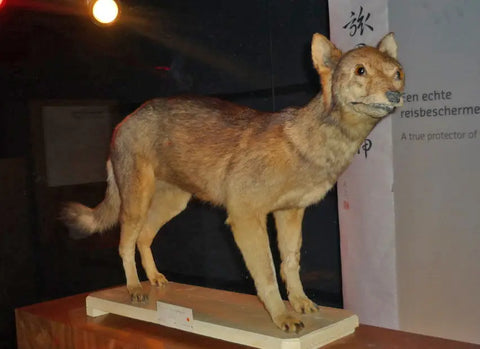The Honshu wolf, also known as the Japanese wolf, was a species of wolf native to Japan. Though it is now extinct, it played a significant role in Japanese history and culture. Let's take a closer look at this mysterious creature.
Appearance and Habitat of the japanese honshu wolf
The Honshu wolf was a medium-sized wolf, standing at around 70cm tall and weighing approximately 25kg. It had a distinctive, reddish-brown coat and a short tail. The species was native to Honshu, the main island of Japan, and was once found throughout the island.

Cultural Significance
The Honshu wolf played a significant role in Japanese culture, appearing in many works of art, literature, and even in local folklore. It was often depicted as a powerful and noble creature, revered by many. The wolf also appeared in traditional Japanese dances, known as "Kagura," where it was thought to bring good luck and ward off evil spirits.
Honshu-Wolf in Japanese Folklore
In Japanese folklore, the Honshu wolf is often portrayed as a powerful and mystical creature with supernatural abilities. Legends suggest that the wolf could communicate with humans and other animals, and that it possessed the power to shape-shift into human form. According to some stories, the Honshu wolf was even revered as a deity by certain local communities, who believed that it could bring good fortune and protect them from harm.
The Honshu wolf has also been featured prominently in Japanese art and literature throughout history, and continues to be a popular subject in contemporary media. In many depictions, the wolf is shown as a fierce and majestic creature, symbolizing strength, courage, and loyalty. However, the wolf is also associated with death and the afterlife in some traditions, and is sometimes seen as a harbinger of bad luck or misfortune.
Despite its cultural significance, the Honshu wolf has been extinct for over a century, and its true nature and behavior remain largely unknown. Nevertheless, the wolf continues to capture the imagination of many people in Japan and around the world, and serves as a reminder of the rich cultural heritage and natural beauty of the Japanese archipelago.
Legends about the Honshu-Wolf
There are several legends in Japanese folklore that involve the Honshu wolf. Here are some of the most well-known ones:
- Shiranui: This legend tells the story of a Honshu wolf named Shiranui who fell in love with a human woman. Shiranui could transform into a human, and he used this ability to court the woman. They eventually got married and had children, but their happiness was short-lived as Shiranui was killed by a hunter.
- Yamaarashi: Yamaarashi was a Honshu wolf who had the ability to control the wind. It was said that he could call up fierce storms and tornadoes when he was angry or upset. Yamaarashi was feared by many, but he was also respected for his power.
- Ookami no Namida: This legend tells the story of a Honshu wolf who was captured and killed by humans. As the wolf lay dying, she shed tears that turned into beautiful crystals. These crystals were said to have the power to heal any illness or injury.
- Shishigami: Shishigami was a powerful Honshu wolf who lived in the mountains. It was said that he could control the animals and plants around him and that he was a protector of the forest. In some versions of the legend, Shishigami is depicted as a fierce, wolf-like creature, while in others, he appears as a more humanoid figure.
These legends show the significance of the Honshu wolf in Japanese folklore and the deep connection between the people and the natural world.
Extinction
Unfortunately, the Honshu wolf became extinct in the early 20th century due to hunting, loss of habitat, and disease. The last known sighting of the species was in 1905, and the last confirmed specimen was caught and killed in 1907. Despite efforts to protect the species, including government protection in 1889, the Honshu wolf was unable to survive.

Rumors about possible survival
There have been various rumors and sightings of possible Honshu wolves surviving in remote regions of Japan, including the Chichibu region in Saitama Prefecture and the Noto Peninsula in Ishikawa Prefecture. However, none of these claims have been scientifically proven, and it is widely believed that the Honshu wolf is extinct.
In recent years, there have been efforts to revive the Honshu wolf through genetic research and reintroduction programs, but these efforts are still in the early stages and face numerous challenges, including limited genetic samples and the difficulty of reintroducing a species into a changed and fragmented ecosystem.
Despite the uncertainty surrounding the Honshu wolf's survival, its legacy lives on in Japanese culture and folklore, where it continues to be celebrated as a symbol of resilience and adaptability.
Legacy
Although the Honshu wolf is now extinct, it remains an important part of Japanese history and culture. Its image can still be found on various traditional items such as paintings, clothing, and even in modern-day logos. The wolf is also a symbol of Japan's rich natural heritage and serves as a reminder of the importance of conservation efforts.
Conclusion
The Honshu wolf may be extinct, but its legacy lives on. Its cultural significance and the tragic story of its extinction serve as a reminder of the importance of protecting endangered species and preserving our natural heritage.


